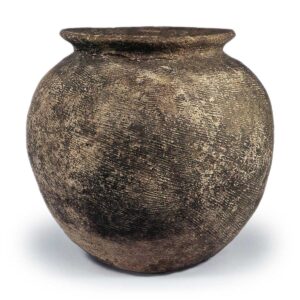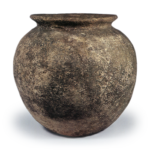
Excavated from Aza-Takaidani, Kawaguchi, Oaza-Kawaguchi, Fukudo Town, Kume-gun, Okayama Prefecture
13th century
Height 37.8 cm, mouth diameter 27.6 cm, body diameter 39.8 cm, bottom diameter 17.5 cm
Tokyo National Museum
The short, U-shaped neck and spherical body, as well as the fine, diagonal striated patterning on the vessel’s surface, suggest that this jar is made of earthenware. The origin of these features, which at first glance appear to be earthenware jars, is necessary to investigate the character of Kameyama ware. The clay used is coarse clay, and the firing is not very good. The firing process is not very good, and there is significant peeling on the interior and exterior surfaces, perhaps due to weak pounding.
This is the material that best demonstrates the characteristics of Kameyama ware, whose main products were miscellaneous daily wares.








